A warm welcome to you, and thanks for joining me on another walk around London! Throughout my walks of the capital I’ve explored many parks, and today I shall be exploring two of South London’s most wonderful natural spaces. My walk begins in Clapham Common takes me via Battersea Park before ending along the Thames at the splendid Albert Bridge.
I’ll admit I’d never actually been to either Clapham Common or Battersea Park before this walk, so for me it was even more exciting to do!
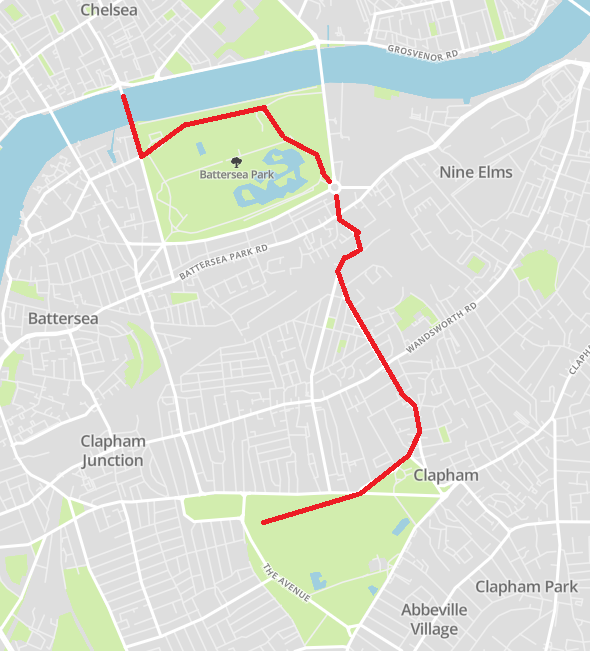
My journey starts in Clapham Common which dates back to the late 17th century when the recreational area was used for horse racing and cricket. It wasn’t until the 1760s when a wealthy local resident by the name of Christopher Baldwin led an initiative to improve the Common by leveling it off and filling in its ditches and planting trees.
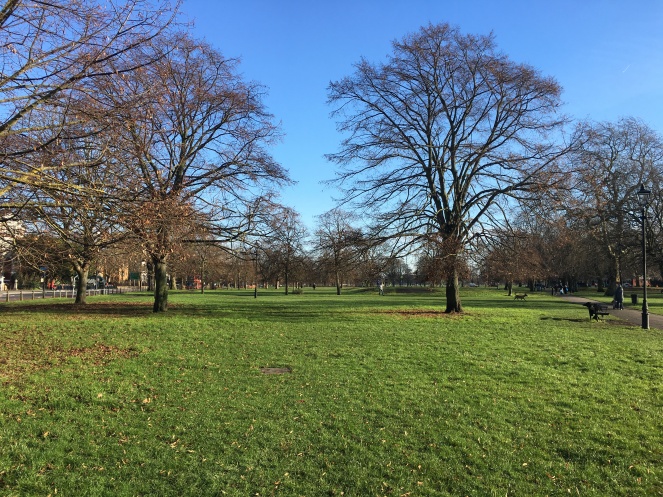
During the 19th century the Common was managed by a group of local trustees who continued to level it out and plant trees. As late as the 1920s sheep were still grazing on the Common, though it was now becoming a well-known area of leisure for people within the suburb which was growing both in size and wealth.

However, in the 1860s Commons in London were at risk of being sold to developers as new legislation meant they could be purchased for the benefits of the public. In 1877, the Metropolitan Board of Works bought Clapham Common from its Manorial Owners with its aim to be ‘free and unenclosed forever’!

Both the board and its successor, the London County Council, continued to make improvements to it and in 1890 they responded to public demand to build one of the largest and best surviving Victorian bandstands in the country.
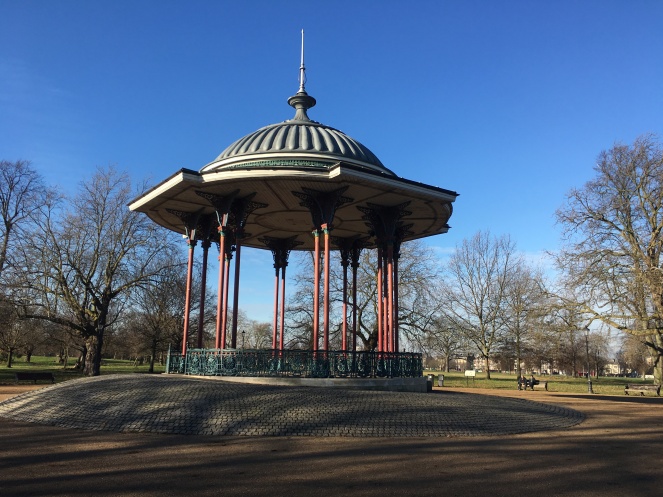
During the First World War troops would be trained in digging trenches on the Common. Whilst in the Second World War the site was used for big events and housed an anti-aircraft battery, with bomb shelters being dug within it.
Sports facilities and entertainments continued on the Common after the War with the London County Council and its successor, the Greater London Council, making improvements to it. The Common was the venue for the International London Horse Show from 1954 to 1985. However, by the 1990s local residents became unhappy with the large scale concerts and other events which they thought were unsuited and damaging the local recreational space. Since 1971, the Common has been owned and managed by the London Borough of Lambeth.
Today, it’s 220 acres of wonderful grass areas, the lovely Mount Pond, many football pitches, and is one of London’s most famous Commons. I did love standing by the pond, with all you can hear is the sound of the birds and the wind, truly the definition of peaceful!



Opposite the Bandstand you’ll find the very popular and convenient La Baita, which in Italian means ‘the hut’. This cafe serves authentic Italian cuisine with sandwiches and drinks offered too. The perfect way to sit there and enjoy the Common on a sunny day.

Outside Clapham Common you’ll find the pretty St. Barnabas Church which was erected in 1897.

It’s now time to continue my walk through Clapham Common and along the main road to Battersea Park.
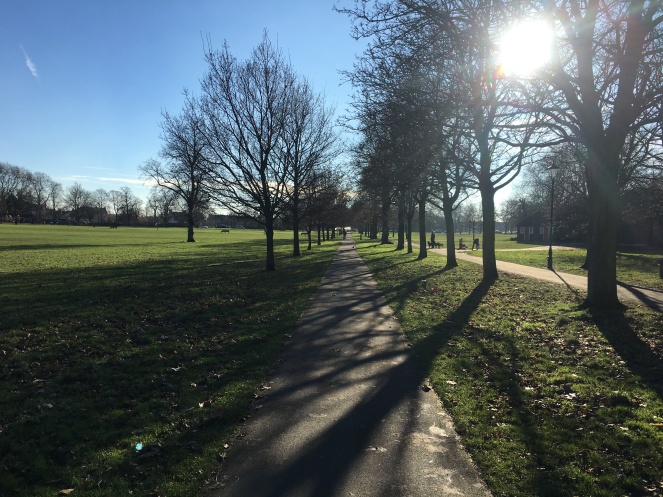
Along my walk I go past Battersea Park train station, and this rather vintage railway bridge!
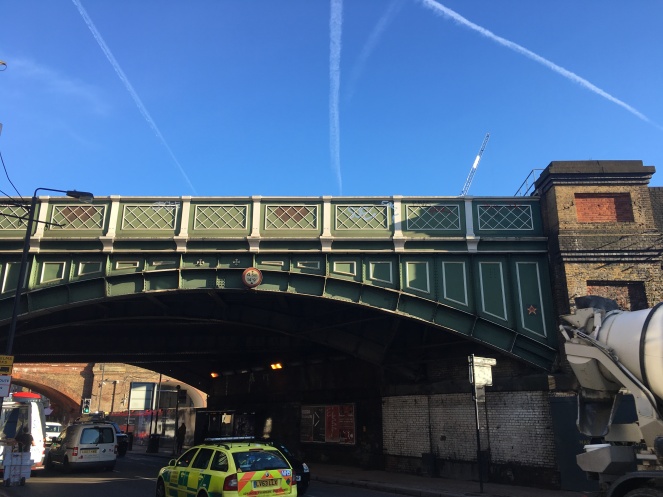

Back in 1843 property developer Thomas Cubitt and the local vicar, the Honourable Reverend Robert Eden, reported to Queen Victoria’s Commison on improving the Metropolis. In 1846 an Act of Parliament was passed which gave to the authorisation of a formation of a park on part of Battersea Common and Battersea Fields.

A year before in 1845 architect James Pennethorne produced a preliminary layout of the park, but it wasn’t until 1854 when the main developments of the park took place. The park was formally opened to the public by Queen Victoria in 1858.

Like with Clapham Common, the park was used during the First World War. Allotments were laid out in the park, an anti-aircraft station was set up on the croquet field, and a clothing depot was installed on one of the cricket fields. The park was also used during World War Two for an allotment, a piggery, an experimental radio station, and the running track became an anti-aircraft gun site. Today, the 200 acre park is managed by Wandsworth Council.
It’s not just Clapham Common that has a beautiful and picturesque pond, as Battersea Park has this amazing one too!

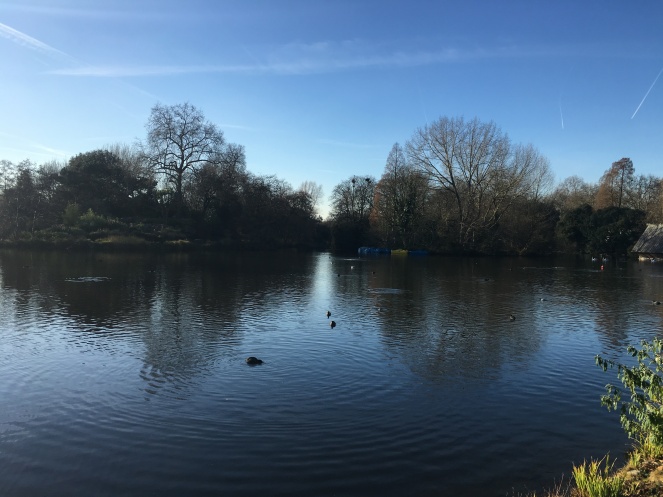

Every pond should have somewhere to enjoy its splendour, and next to it you can relax in this riverside cafe!
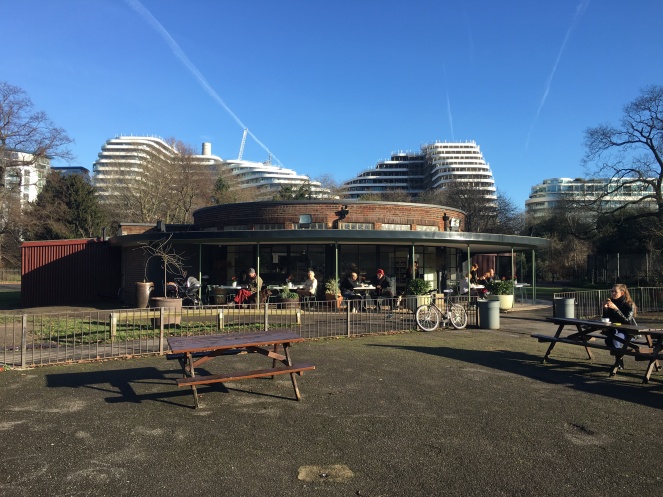
It’s only when you walk through the park that you find out how vast it is! Also the hidden gems within it keep appearing with more ponds and pathways filled with trees.


Near the northern side of the park sits the Festival Gardens that were designed by Russell Page. In 1951 they were transformed into the ‘Pleasure Gardens’ as part of the Festival of Britain which celebrated the British industry, arts and science to promote the feeling of recovery after the World War.

The event was intended to be a one-off year exhibition, but the fun fair remained there as a permanent attraction until it closed in 1974.


One of the eye-catching features within the park is this cool metal structure!


At the end of Festival Gardens you find the distinctive and rather amazing structure of the Peace Pagoda. Regular London Wlogger readers will remember another Pagoda appearing in Victoria Park in one of my previous walks!

The construction of the Peace Pagoda actually relates to the unlikely town of Milton Keynes in the UK. Back in 1978, the Reverend Gyoro Nagase arrived in England from Japan to assist with the construction of the first Peace Pagoda in the UK in Milton Keynes. Now you might think, it’s very random for a famous Japanese religious monument to be in Milton Keynes, but there is logic behind it! Back in the seventies when the new town of Milton Keynes was being developed, one of the planning advisers had visited Sri Lanka where he saw a Peace Pagoda. It was proposed to the Milton Keynes Development Corporation who loved the idea, and it remains there today.
In 1984, Reverend Gyoro Nagase moved to London to assist with 50 volunteers and Buddhist monks and nuns of the Nipponzan Myohoji Buddhist Order to construct the Peace Pagoda in the park, and its amazing structure was completed in 1985.
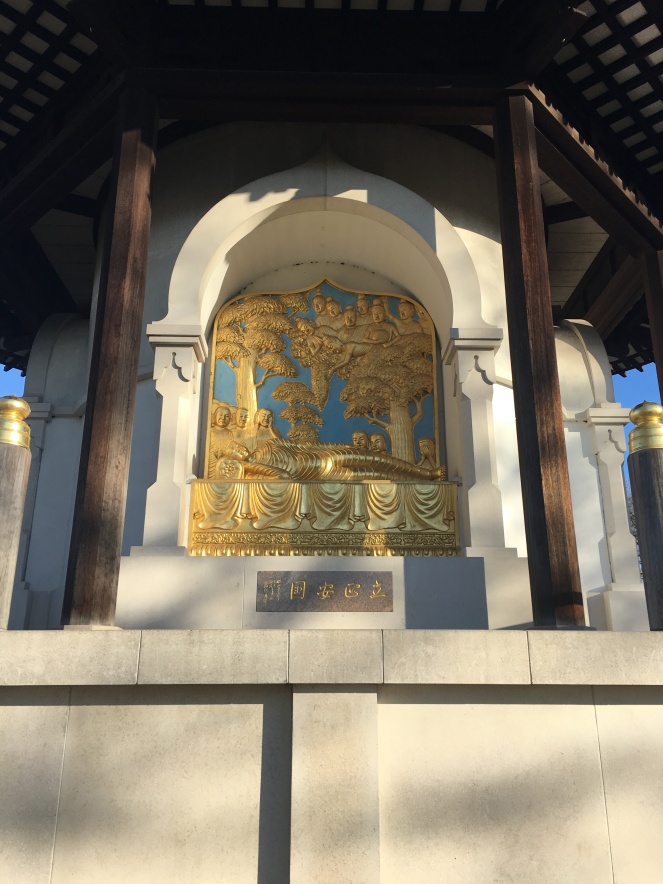


To get to my final destination today I need to take a walk along the side of the Thames, and the view across it is simply stunning from the Peace Pagoda. You can tell I enjoyed taking videos on this walk!


A famous place for morning joggers and dog walkers, I walk along the side of the river to reach The Albert Bridge!

Located over the River Thames connecting Chelsea on the north bank to Battersea on the south bank, the Albert Bridge was designed and built by Rowland Mason Ordish in 1873. However, it proved to be structurally unsound, so between 1884 and 1887 Sir Joseph Bazalgette incorporated design elements of a suspension bridge to it.

Two concrete piers were added to it to further strengthen it in 1973, which means today the bridge is an odd hybrid of three different design styles! For six years after it was opened it became a toll bridge, though this was unsuccessful and the charge was lifted.

The bridge was given the nickname of ‘The Trembling Lady’ as it had the tenancy to vibrate when large numbers of people walked across it. The entrance sign to warn troops from the nearby Chelsea Barracks is still there today.
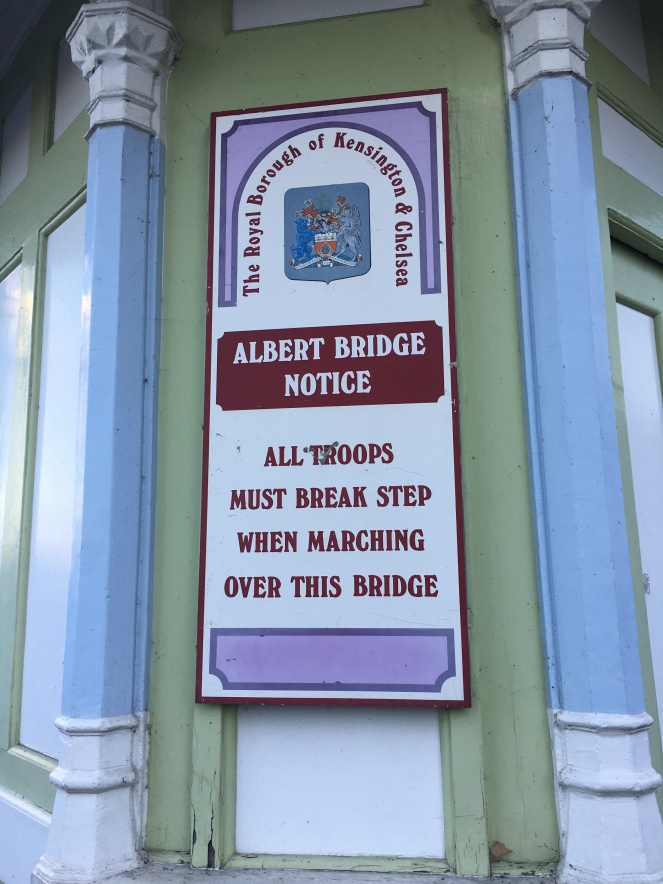
Today, there are still traffic control limits over it to prolong its life, making it the least busy of London’s bridges. The bold colouring of the bridge was painted on it in 1992 to make it more visible for ships, and I think you’d find it hard to miss it! At night the bridge is illuminated with 4,000 bulbs, and with Grade II listed status it’s one of the capital’s riverside icons.
The view from it you can imagine is amazing! On one side you can see the Chelsea Bridge, and on the other is Battersea Bridge.

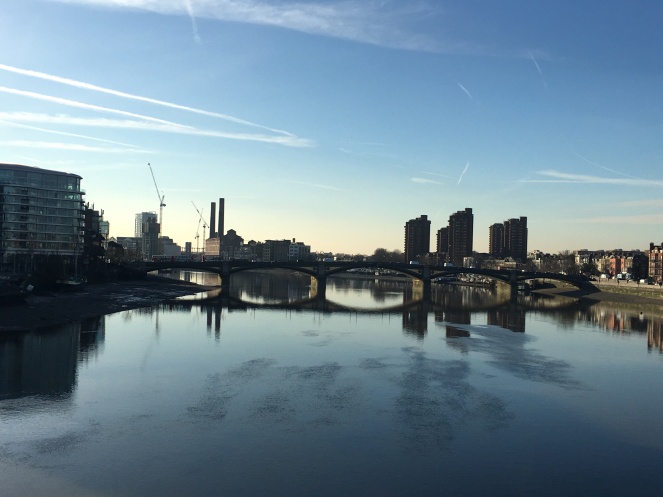
I couldn’t think of many nicer places to end a walking adventure of London! I’ve taken a trip through South London to visit a famous Common, Park and Bridge, and seen how the first two played their part in both World Wars. Hope you had a great time reading my walk, and please share your thoughts below! Whilst I have you here, you can give me a follow on Twitter, Instagram and Facebook, and don’t forget to sign up to my blog too!
I’ll see you next week!
Sources: (not the food sauces)
All photos taken by London Wlogger. © Copyright 2017
History of Clapham Common – Clapham Common Management Advisory Committee
History of St Barnabas Church – British History Online
History of Battersea Park – Historic England
History of the Festival of Britain – Historic UK

More nostalgia for me. I used to go to school in Clapham – we used to have our netball matches on the common – and, as a teenager, was often to be found propping up the walls of the Waltzer ride at Battersea Park fun fair listening to the music and checking out the boys. I’m embarrassed to say I took absolutely no notice of the history or architecture surrounding me so thank you for opening my eyes to it all if a bit late!
LikeLiked by 3 people
Thanks for sharing your lovely memories! Glad to hear I could enlighten you more on the areas 😊
LikeLike
what a nice day for a walk in the park:)
LikeLiked by 2 people
The weather in London recently has been pretty grim, so it was one of the few good days in the past month or so!
LikeLiked by 1 person
Lovely tour, lovely views.
I never knew that structure was called a Peace Pagoda! Very cool.
LikeLiked by 3 people
I didn’t even know it was there! It’s so hidden away!
LikeLiked by 1 person
I used to go to those two park and had a friend who lived in Clapham. Nice to see it again and read the history.
LikeLiked by 2 people
Thanks for sharing your memories, Sherry 😊 Glad you found it fascinating!
LikeLiked by 1 person
Fantastic Post! 😉
LikeLiked by 2 people
Thank you! 😊
LikeLike
I love looking at your pictures. I used to walk around Battersea Park a lot and I used to live near Clapham Common off Northcote Road. It brings back so many happy memories.
LikeLiked by 2 people
Great to hear it was a nice trip down memory lane 😊
LikeLiked by 1 person
This was a beautiful walk which I enjoyed greatly.
LikeLiked by 2 people
Excellent, glad to hear, Anne! 😊
LikeLiked by 1 person
great you can survive south of the river…!! so when can I get you to Herne Hill or dulwich and introduce you to the parks. A short train ride, plenty of cafes and lots of history!!
LikeLiked by 2 people
Haha, it might feature soon…!
LikeLiked by 1 person
Well if you do want a companion ..
LikeLike
So many wonderful green spaces in the centre of the city.
LikeLiked by 2 people
It seems like everywhere you look there is a hidden and beautiful green area!
LikeLike
Keep meaning to mention, if you compress your photos before uploading, you’ll use less storage and they will load faster for the reader.
It’s amazing how much open green space there is in London.
LikeLiked by 2 people
Thanks for the tip! It’s incredible that you’re never too far from a park or garden!
LikeLike
Thank you for sharing your walks of London. I live in Australia now and it’s almost like being back for a while. Excellent photo’s and thank you for all the historical bits and pieces too.
LikeLiked by 3 people
Glad I could bring you closer to the capital 😊 Hopefully you can visit soon!
LikeLike
loved the post and the pictures. Many moons ago when my sister got married in London my mum and I flew over and we stayed in Clapham.
LikeLiked by 1 person
It’s a really nice area to be around, great green spaces, shops and pubs!
LikeLiked by 1 person
Love the clear blue skies and all the greenery.
LikeLiked by 1 person
London takes credit for how beautiful it looks!
LikeLiked by 1 person
What a fabulous walk! I love your posts – they bring back such wonderful memories of London. Incredible photos too.
LikeLiked by 2 people
Thank you so much! Glad I can bring you on a trip down memory lane!
LikeLiked by 1 person
Great photos, appreciate the history and know you must have worked miles! Well done and thank you I totally enjoyed it.
LikeLiked by 2 people
Glad you to hear you enjoyed it 😊
LikeLiked by 1 person
I had no idea there were so many open spaces in London. Great pics. 🙂
LikeLiked by 1 person
You never too far away from a park!
LikeLike
I’ve only been to London once and that was for a short time 40 years ago. Missed all of this.
LikeLike
A lovely read!…. I lived in London for some years and adored the parks, old churches and Victorian bridges… Oases of nature and glimpses into history that only the ‘Town and Country’ city can afford- long may it stay that way… I remember fishing the small pond on Clapham Common near to the road and just down from the Mill on the Common pub…
LikeLiked by 1 person
Thanks for sharing your lovely memories, Gareth, and I’m glad to hear you enjoyed reading it 😊
LikeLike
I really enjoyed your walk and photos and the historic treasures. Thanks 🙂
LikeLiked by 1 person
Thanks Laura, stay tuned for lots more fun walks 😊
LikeLike
Oooo I adore Battersea Park! It’s one of those places that you discover after a few years in London. What a treat.
LikeLiked by 1 person
I couldn’t agree more! It’s only when you explore the outskirts of London do you find it!
LikeLike
Wonderful. Hope to see these sites soon.
LikeLiked by 1 person
Excellent, you’ll have the perfect guide for your walks 😊
LikeLike
love the photos Stu
LikeLiked by 1 person
Thank you so much! 😊
LikeLike
Wonderful walk. I’ve walked part of it, Clapham Common area, and it’s a lovely walk. Thank you for sharing photos and so much information. I’ve been living in Spain for a long time, so I hope to be taking more of your virtual London walks 🙂
LikeLiked by 1 person
That’s great to hear, thanks for joining me! Hope you enjoy all my upcoming walks 😊
LikeLiked by 1 person
A fabulous walk with so much amazing history attached along the way. I love the two parks with the beautiful lakes and your photos of them are excellent. Interesting history about the Albert Bridge, too.
LikeLiked by 1 person
Aww thanks so much, Millie! I do love a London park and pond!
LikeLike
I love London! I’ve been there once! I’m looking forward to your pictures and posts! ❤️
LikeLiked by 1 person
Thanks Ipuna, glad you could join me on my walks 😊
LikeLiked by 1 person
You have a fascinating blog and its so well researched too. Thank-you very much for visiting mine and for the follow.
LikeLiked by 1 person
Thank you, glad it was an insightful and interesting walk for you 😊
LikeLiked by 1 person
Been there once. That pagoda looks nice, it give difference architectural theme.
LikeLiked by 2 people
It’s very hidden behind the trees! But such an amazing landmark!
LikeLike
Oh wow… So insightful for someone who has never being there.
LikeLiked by 1 person
Thank you, hopefully you can do these walks for real soon!
LikeLiked by 1 person
Ha… Hopefully 😄
LikeLiked by 1 person
Thank you for visiting my little blog and the follow.
Although I have never had an opportunity to visit London, and probably never will, I am an avid armchair traveler. 🙂 I bet the Scrubs of Battersea Park are beautiful in the Spring and Summer months! Hope you don’t mind me wandering through your archives when I get time.
LikeLiked by 1 person
No no please do have a read through all my walks! 😊 Thanks for joining me!
LikeLike
You are very welcome!
LikeLiked by 1 person
Thank you for the beautiful tour, visuals and information. Feel like I’ve been there 🙂 God Bless
LikeLiked by 1 person
Awesome, that’s so nice to hear that I can bring you closer to the great city of London!
LikeLiked by 1 person
We had a lovely time on this walk. It was a very rainy day in February. Your guide to the highlights is very good. Memorably at Battersea Park we ended up walking into the middle of a Tom Cruise movie location!
LikeLiked by 1 person
Awesome glad to hear you had a great day! I had a fantastic time as well, thoroughly enjoyed it 🙂
LikeLike